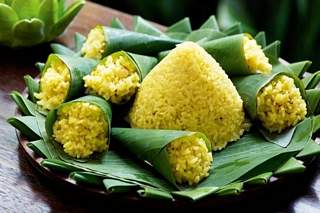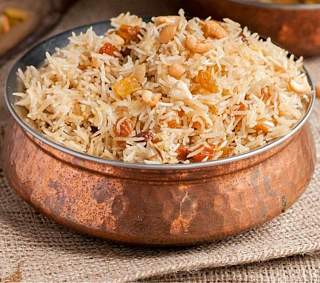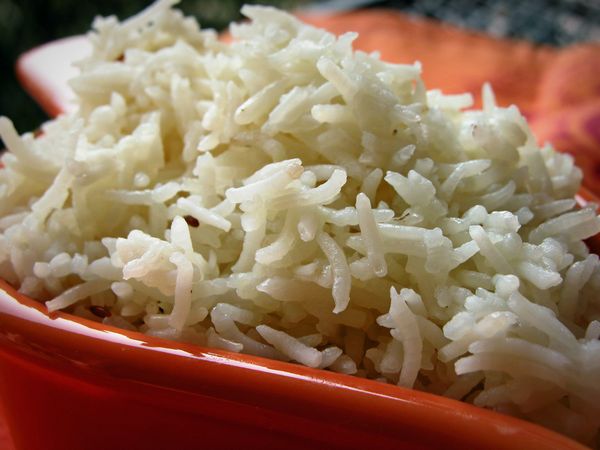 Rice colored with turmeric and shaped into a cone is a common sight during festive occasions in Bali and Java. The conical shape echoes that of the mythical Hindu mountain, Meru, while yellow is the color of royalty and one of the four sacred colors for Hindus.
Rice colored with turmeric and shaped into a cone is a common sight during festive occasions in Bali and Java. The conical shape echoes that of the mythical Hindu mountain, Meru, while yellow is the color of royalty and one of the four sacred colors for Hindus.
Even in Muslim Java, this traditional festive dish remains popular, and is accompanied by sambal trasi, classic grilled chicken, and eggs in fragrant lemongrass sauce.
Ingredients for Indonesian Nasi Kuning
- 2 inch fresh turmeric, peeled and sliced and two tsp ground turmeric
- 1/4 cup water
- 1.5 (300 g) cup uncooked rice, washed and drained
- 1.5 cups (375 ml) thin coconut milk
- 1/2 cup (150 ml) chicken stock or 1/4 tsp chicken stock granules dissolved in 1/2 cup warm milk
- 1 salam or pandanus leaf
- 1 stalk lemongrass, thich bottom third only, outer layers discarded, inner part bruised
- 1 inch (2.5 cm) fresh galangal, peeled and sliced
- 1 tsp salt
Accompaniments for Indonesian Nasi Kuning
 Freshly sliced cucumber and tomato
Freshly sliced cucumber and tomato- 1 portion sambal trasi
- 1 portion grilled Indonesian chicken
- 1 portion sambal goreng tempeh
- 1 portion eggs in fragrant lemongrass sauce
- Emping (melinjo nut wafers)
Procedure for Indonesian Nasi Kuning
- Grind the turmeric and water in a mortar until fine. Strain through a sieve to extract all the juice. Discard the solids. If using ground turmeric, dissolve the powder in two tsp of water
- Combine the rice, turmeric juice, coconut milk, chicken stock, salam or pandanus leaf, lemongrass, galangal, and salt in pot and bring to a boil over high heat. Reduce the heat to medium and simmer cooked until the liquid is absorbed, 10 to 15 minutes, then reduce the heat to low and cook for 5 to 10 more minutes, until the rice is dry and fluffy. Remove from the heat and mix well. Alternatively, cook the rice and ingredients in a rice cooker.
- Discard the salam or pandanus leaf, lemongrass, and galangal.
- Press the cooked turmeric rice into a cone shaped, if desired. Serve the cooked rice with the accompaniments on the side.

 1.25 cups
1.25 cups 